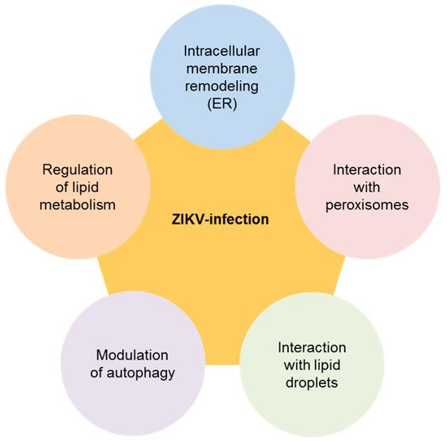Lipidomics in ZIKV Infection
Zika virus (ZIKV) is a mosquito-borne flavivirus. It has recently been the focus of immense investigation due to its correlation to neurological syndromes (Guillain-Barré syndrome) and congenital developmental deficits (microcephaly). Since there are currently no licensed vaccines or antiviral treatments for ZIKV infection, efforts are needed to understand the complex interactions between ZIKV and cell networks. Among them, lipid metabolism gains attention. Creative Proteomics is an international contract research organization (CRO). We provide state-of-the-art equipment and wide-ranging expertise in biotechnological applications to academic and industry clients. Our array of services can be tailored to meet global customers' needs. Here, we focus on lipidomics in ZIKV infection.
Zika virus (ZIKV) and lipid metabolism
Zika virus (ZIKV) is an enveloped positive-strand RNA virus belonging to the Flaviviridae family. Similar to other flaviviruses, multiple stages of the viral replication cycle are closely connected with cellular membranes, including the synthesis of new genome copies and assembly of viral particles within viral replication complexes (RCs). These steps seem to require a specific lipid environment because flaviviruses presumably modify the host's various lipid pathways to create such an environment. More and more studies have indicated that lipids play important roles in cell organization, signaling networks, and viral disease outcomes. Therefore, it is necessary to study how ZIKV perturbs cellular lipid metabolic networks. In addition, research on lipids involved with ZIKV infection may also help explain why the virus infects brain tissue. Brain tissue has a higher lipid content than any other organ, as there are rich lipids surround central and peripheral neuronal cells that help signals travel quickly through the brain.
Roles of lipids during flavivirus (including ZIKV) infections, including
- Lipids and flavivirus entry (Phospholipid receptors, and membrane fusion)
- Lipids and flavivirus replication
- Lipids and flavivirus assembly (the composition of flaviviral lipid envelope)
- Flaviviruses and lipid droplets
- Lipids, immunity, and flaviviruses
Transcriptomic and lipidomics analysis of ZIKV-infected cells in mosquitoes, microglia, and retinal pigment epithelial cells show that ZIKV infection significantly modulates lipid metabolism. The remodeling of host lipid metabolism involves sphingolipids (sphingomyelin and ceramide), glycerophospolipids (phosphoglycerides), plasmenyl-phosphatidylethanolamines, lysophospholipids (lysophospha-tidylcholine), and so on. Despite the specific roles of these lipids in the viral infection yet to be identified, they may be involved in key processes ranging from virion biogenesis, membrane remodeling, genome replication, and neuronal differentiation to autophagy and apoptosis regulation.
 Fig1. Multiple connections of the Zika virus (ZIKV) with lipid metabolism. (Martín-Acebes, M. A., et al, 2019)
Fig1. Multiple connections of the Zika virus (ZIKV) with lipid metabolism. (Martín-Acebes, M. A., et al, 2019)
Lipidomics in ZIKV infection
A recent study demonstrated that conducted a global lipidomics investigation of ZIKV-infected human cells, mapping a host-virus wiring diagram of sphingolipid metabolism in human cells. The result showed that ZIKV regulated cellular sphingolipid metabolism, selectively increasing ceramide production and then enriched at viral replication sites. Additionally, a study has shown that plasma lipidome alterations associated with antenatal exposure to ZIKV can facilitate the identification and monitoring of clinical phenotypes at birth and even in childhood. By comparing the plasma lipidome profiles of ZIKV exposed microcephalic and normocephalic newborns as well as non-infected controls, there are major alterations in circulating lipids, including 13-HODE isomer, lysophosphatidylcholine, other oxidized lipids, and several circulating free fatty acids.
Creative Proteomics has been developing metabolomics detection methods and data analysis methods for many years. Based on professional scientists and advanced platforms, we can accelerate our customers' projects to the next level. For more information on how we can help you, please feel free to contact us.
References
- Martín-Acebes, M. A., et al. (2019). "Lipid metabolism as a source of druggable targets for antiviral discovery against zika and other flaviviruses." Pharmaceuticals, 12(2), 97.
- Leier, H. C., et al. (2020). "A global lipid map defines a network essential for Zika virus replication." Nature communications, 11(1), 1-15.
- da Costa Faria, N. R., et al. (2021). "Plasma lipidome profiling of newborns with antenatal exposure to Zika virus." PLoS neglected tropical diseases, 15(4), e0009388.
Related services
* For research use only.

 Fig1. Multiple connections of the Zika virus (ZIKV) with lipid metabolism. (Martín-Acebes, M. A., et al, 2019)
Fig1. Multiple connections of the Zika virus (ZIKV) with lipid metabolism. (Martín-Acebes, M. A., et al, 2019)